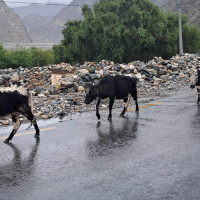- Monday, 26 May 2025
Monsoon likely to affect 450,000 households this year
By A Staff Reporter,Kathmandu, May 26: As the pre-monsoon nears its end, the arrival of this year's monsoon season is just around the corner. The government has projected that approximately 2 million citizens, spanning over 450,000 households, could be adversely affected by climate-induced disasters during this monsoon.
This estimation has been outlined in the Proposed National Monsoon Preparedness and Response Action Plan-2025, which was developed by the National Disaster Risk Reduction and Management Authority (NDRRMA) based on forecasts from the Department of Hydrology and Meteorology (DHM).
The action plan was formulated through a comprehensive analysis of various risk parameters.
Dinesh Prasad Bhatta, Chief Executive Officer of the National Disaster Risk Reduction and Management Authority (NDRRMA), said that around 10 per cent of the affected population may require rescue and relief interventions.
“We have assessed that around 2 million people across all provinces are likely to be affected.
Accordingly, responsibilities have been regionally allocated to ensure effective preparedness,” he said.
The plan meticulously evaluates available emergency resources, additional requirements, and logistics across all tiers of government—federal, provincial and local.
It will be tabled at the upcoming meeting of the Disaster Risk Reduction and Management Executive Committee, chaired by the Home Minister, on May 28, for approval and immediate implementation before the onset of the monsoon.
A new feature of this year's strategy is the introduction of monthly monitoring, evaluation, and review mechanisms throughout the monsoon season to ensure adaptive and dynamic responses.
The DHM's monsoon outlook has already warned of above-average rainfall and higher-than-normal maximum and minimum temperatures across most parts of the country between June 1 and September 30.
According to Dinkar Kayastha, information officer for the DHM, regions most vulnerable to extreme rainfall include Eastern Karnali, Northern Lumbini, and large parts of Gandaki Province, where the probability of above-average rainfall ranges from 55 per cent to 65 per cent.
Additional areas at elevated risk include Southern Sudurpaschim, Western Lumbini, Northeastern Gandaki, and Northern parts of Bagmati and Koshi Provinces, with a 45 per cent to 55 per cent chance of above-average precipitation.
Meanwhile, Eastern and Southern Madhes, as well as other remaining regions, face a 35 per cent to 45 per cent likelihood of excessive rainfall.















